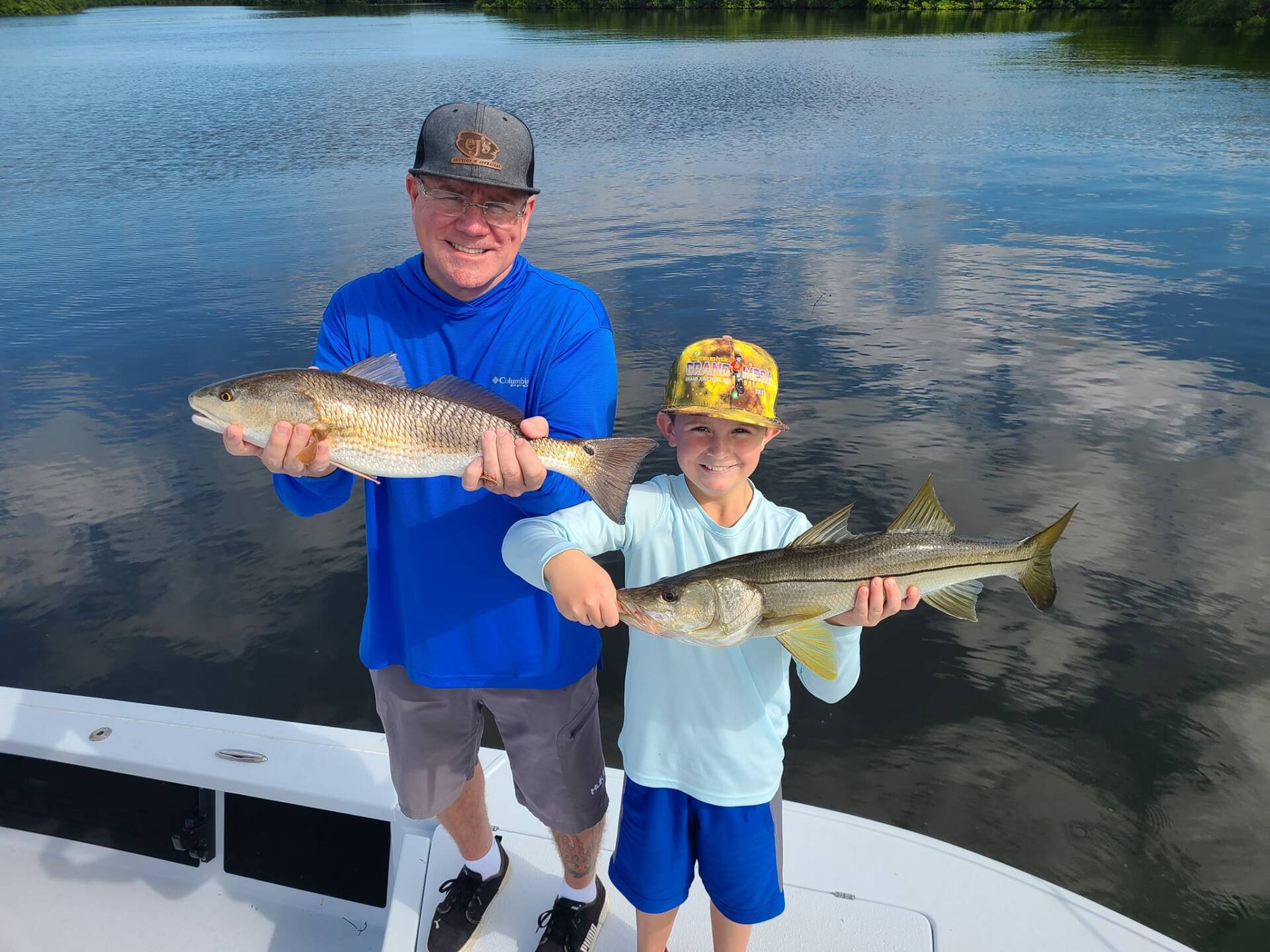Last Updated on October 17, 2025 by Capt. Bucky
In today’s fishing world you are overloaded with choices and decisions to make. Everyday there seems to be new products being showcased and claiming their product is the best. State of the art design, most abrasion resistant, clearest line on the market, and most affordable are just some of the things you will see and hear when shopping for fishing equipment. Where does it end?
I want to keep things simple and just talk to you about your leader line in regards to inshore fishing here in Tampa Bay and just about any inshore fishing around the country. When you think of inshore fishing, three main species come to mind, Snook, Redfish, and Spotted Seatrout. When considering leader line this is not a Lord of the Rings thing, one line does not rule them all! There are so many great choices out there, your main concerns will be selecting the appropriate line type, and the right pound test. Then applying it to your targeted species and the time of year.
Two of your main choices in leader are monofilament line, which is basic leader material, or fluorocarbon leader. You can find these lines in just about any pound test strength from 2-pound test all the way up into the hundreds. Having too strong/think of a leader and you might lose action on your bait, or the fish see it to easily and you run the risk of not getting bit at all. Unless you are trying to set a line class record, having to weak of a leader will leave you with a lot of heart aches.
Nowadays almost everyone I know uses braided line. With its incredible durability, longevity, sensitivity, smaller diameter, and increased casting distance it is almost a no brainer when it comes to your main line. One mistake I do see, is even though it is smaller in diameter, is that a lot of people use too heavy of braided line in regards to what they are fishing for. Typically, I use anywhere from 10 to 20-pound braid. Your choice lies in what brand you want to use, and what type of visibility you want. Meaning do you want to use moss green or something like yellow so you can see it better. I haven’t really noticed a difference in the amount of bite I get using any of the color choices. Some braided lines are multi colored so does it really matter all that much. Fish don’t bite the main line.
Monofilament line is about as basic as it gets. It is less expensive, has a lot of stretch, and very good knot strength. Growing up we used to fish with mono line and a heavier mono leader. It is not very abrasion resistant, it’s more visible when wet, it floats and can develop a memory over time. That means it will retain a coil after being on the spool for too long and that can lead to tangles. I do use monofilament line on all my reels, but that is strictly as a backer. You spool you reel with mono to start and then spool your braid on top of that. This accomplishes two things. One it can keep the line from spinning on the reel, and it allows you to use less of the expensive braid. For example. My reel might say it hold 250-300 yards of 10-pound braid. I can fill two reels with a mono backing and still have over 150 yards of braided line each on top of that. Vary rarely will I have a fish take me to the backing.
You will see spools of line that just say leader material. They are still just monofilament line, but usually in a heavier pound test range. These are great leaders for fishing offshore structure where you can get hung up often and have to break the line. No sense in using expensive fluorocarbon leader when this is the case.
Fluorocarbon leader is what I tend to use most often. Fluorocarbon is certainly more expensive option, but there are a lot of pros to using it. For one thing it refraction index is closer to water making it less visible to fish. It is far more sensitive to vibrations and much more abrasion resistant. It also has less stretch making hooks sets all the better. Knot strength is also very good.
Now that we discussed a little about types of leader material, lets now discuss what pound test to use. Throughout the year I will vary the pound test leader I am using. I typically stay within the 20 to 30-pound test range when targeting the main inshore species.
During the warmer months when the snook are a lot more active and the water is not as clear I typically stay with 30-pound test fluorocarbon leader. I like the Seaguar brands of leader, more specifically the blue label or the STS Slamon. 30-pound test will handle almost all fish and is strong enough to withstand the abrasive mouths of snook and the roots of mangrove trees. When using top water walk the dog style top water lures, or suspending twitch baits, I like to use a little heavier piece of leader with a straight not like the uni-knot. This will keep the line pointing away from the lures and result in less foul hooks.
When the temps begin to fall and the water becomes more-clear, I will start to scale down my leader strength to 25-pound test and eventually to 20-pound. This is usually when I predominately catching a majority of trout and redfish. Fish can sometimes become leader shy and scaling down the leader get result in more bites. If I am targeting trout on artificial or even live bait, I like to use 20-pound test leader. Trout are sometimes subtle eaters and the lighter line and extra sensitivity will help getting the hookup.
I like to use a 3 to 4-foot section of leader. It allows for plenty of length between the knot and the hook and if you do catch a snook or a fish with an abrasive mouth you often have to retire. A longer leader will allow you to do this multiple times before the leader gets too short. My typical knot to connect leader to the main line is a uni to uni knot. This know will never fail. For the leader uni knot I like to go 3 to 4 times around and through and for the braided line knot 7 to 9 times through the loop. Tighten each knot about 90% and them slide them together, and tighten them down. You can cut the tag ends off fairly short with this knot. I will sometimes use an FG knot, but that is when I am casting artificial lures. The knot takes a lot longer to tie, so it’s something I pre tie before going out on the boat. It is also one of the harder knots to tie. Done with the slightest incorrectness and the knot will slip. One thing about knots and longer leaders is that they knot often has to pass through the guides. The more often it does this the weaker and weaker the leader knot will eventually become, so occasionally retying the leader is something you might consider. I hope this helps when you are out on your next adventure. Fishing is fun!


